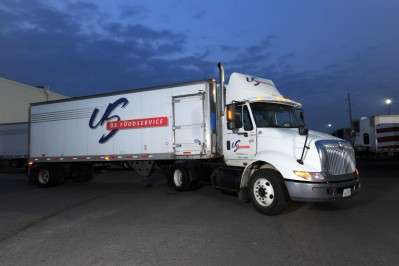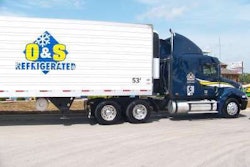 Bernie Cassetori, vice president of fleet management for U.S. Foodservice, says the company's initiatives improved efficiency and lowered costs.
Bernie Cassetori, vice president of fleet management for U.S. Foodservice, says the company's initiatives improved efficiency and lowered costs.Food prices, like nearly everything else in today’s economy, are linked to energy prices. Restaurants, hotels, universities and other foodservice providers risk losing loyal customers by adjusting the prices on their menus. Imagine how you would react to surcharges being added to your food bill. Hundreds of thousands of businesses in the foodservice industry depend on partnerships with their food distributors to turn a profit.
U.S. Foodservice is one of two national food distributors that operate in the multibillion-dollar foodservice industry. Its private fleet, one of the largest in the country, serves more than 250,000 customers with more than 5,000 trucks.
Last year, with diesel prices approaching $5 a gallon, the Rosemont, Ill.-based company faced unprecedented challenges in keeping profits up and costs down for customers. In response, U.S. Foodservice stepped up to the plate to reduce its fuel consumption, curb emissions and keep costs in check. During 2008, the company saved $8.2 million in fuel costs and avoided 22,000 metric tons of CO2 emissions (equivalent to more than 4,400 cars) by improving the efficiency of its fleet – as measured in freight tons per gallon of fuel – by more than 4 percent from 2007.
Prior to last year’s soaring fuel prices, U.S. Foodservice always had used miles per gallon to measure fuel efficiency. In May 2008, the company changed its focus to a new metric – freight tons per gallon – as management saw that its improvement efforts for mpg alone were not gaining enough traction. “We had been making improvements, but we were looking at the wrong piece of data,” says Bernie Cassetori, vice president of fleet management.
The shift toward tons per gallon came after U.S. Foodservice partnered with a nonprofit firm to help it measure and reduce carbon emissions. In the process, the fleet began to use this new metric to chart improvements, but that was just the beginning. The company used the fuel-price crisis as an opportunity to launch new initiatives to put more freight on delivery trucks while reducing the number of miles, stops and routes to boost profits and keep customers’ costs in line.
Profiting by efficiency
Even before fuel prices hit all-time highs, an ongoing initiative at U.S. Foodservice was taking shape. The company’s operations team had been looking for ways to control costs without raising product prices. For this initiative to succeed, operations needed to consolidate deliveries and reduce mileage in truck routes, Cassetori says.
The initiative started in operations but grew to become a joint collaboration project with the sales department. U.S. Foodservice organizes its sales and operations in geographical regions. In each region, operations meets regularly with sales and provides information about the proper days each customer should be getting deliveries to maximize efficiency. “We would never say to a customer ‘This is the only day you are getting a delivery,’ ” Cassetori says. “The sales department always wins the customer service argument.”
But Cassetori says that by optimizing delivery schedules, such as taking deliveries two times a week instead of three, U.S Foodservice can offset some of the fuel increases through operational efficiencies. High fuel prices made customers more receptive and understanding to changes that would help keep their costs in check. “We looked at optimization when fuel prices went wild,” Cassetori says. “It was an opportunity to re-engineer how we delivered.”
U.S. Foodservice recently experimented with new route optimization and planning tools to create more efficient deliveries. Preliminary models show the potential for significant cost savings by reducing the number of miles and routes for deliveries.
Managing drivers
Even with a new metric in place to manage improvements in fuel efficiency, management continued to focus on improving miles per gallon (mpg) by targeting the usual areas: speed, shifting and idling. Creating friendly competition among drivers has paid the biggest dividend; the company offers small incentives to drivers for earning the highest score in their region for shifting patterns, idle times and other safety and performance areas.
When U.S. Foodservice began scoring and ranking its drivers for performance, 40 percent of them scored below 90 percent for performance; today, none score below 90 percent, and more than 33 percent of drivers score at least 99 percent. “The scorecard provides a great tool for discussion and has really helped our supervisors work more collaboratively with our drivers,” Cassetori says.
In addition to focusing on fuel efficiency by driver, management took a closer look at all activities that consume fuel. “As we continued to focus on the driver side of it, we realized it wasn’t actually the driver but the truck you had to monitor,” Cassetori says. Monitoring idle time by driver didn’t account for the time trucks were idling in the yard without a driver assignment. “There were a lot of hours there that we were missing,” he says.
Other measures taken to improve mpg include purchasing tire inflation systems on all new trailers and improving pre-cooling processes for reefer trailers when loading product. Management also is considering adding trailer skirts to achieve an additional fuel savings of up to six or seven percent, Cassetori says.
For tractors, U.S. Foodservice worked with its major engine supplier to adjust speed limits and program its engines to shut down automatically after five minutes of idling. The company also began using gear-down protection; the engine will not allow a driver to surpass 60 mph until the driver shifts up from ninth to 10th gear in a 10-speed transmission. U.S. Foodservice also saw significant fuel economy improvements by assigning drivers with poor shifting behaviors to vehicles with automatic transmissions, Cassetori says.
Besides using technology to improve efficiency, U.S. Foodservice also is investing heavily in new safety technology. The company is installing lane-departure warning systems in all tractors that are used for shuttling freight overnight between hubs and is adding stability control systems on all new equipment purchases.
As another cost-saving measure, U.S. Foodservice has made significant headway in finding backhaul freight to minimize empty miles. Its backhaul business has grown by more than 22 percent in the first four months of 2009 versus the same period in 2008, Cassetori says.
With all of the company’s ongoing initiatives and processes to improve freight tons per gallon and other important metrics, handling the next fuel-price crisis may be a breeze by comparison. “Basically, execution is all it comes down to,” Cassetori says. “This is a simple business if we execute properly.”











